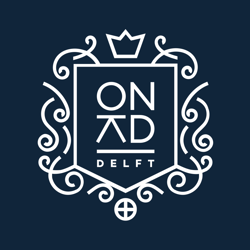Exhibition in the Old Church of Delft
DEATH - Remember Me (Part 7)
A PILE OF SAND IN THE CHURCH
Do you see that pile of sand in the middle of the church? In the past, this was not an unusual sight. This church was once more than just a place where church services were held. Here, beneath the floors and surrounded by ancient walls, the dead lay buried.

At each funeral, several floor stones were lifted and a new grave was dug or space was made. After the interment, the sand was placed back over it, thus entrusting the deceased to consecrated ground. In the silence of this church, the boundary between life and death became blurred. The living and the dead shared the same space.
HUNDREDS OF NAMES, HUNDREDS OF STORIES
Of the people buried here in the Old Church of Delft, we sometimes know a great deal, but sometimes only a name. There are also graves where the names are no longer decipherable. Yet everyone chose to be buried here so as not to be forgotten; hoping that their names would still be spoken even centuries later and their stories told. For this is how we remember: by telling stories about those who are no longer with us.
CHARITY: CLARA VAN SPAERWOUDE
Someone about whom we know a lot is Clara van Spaerwoude. You can find her striking epitaph on the column near the great organ. It reads 'Van herten claer' (Clear of heart), a beautiful reference to both her name and her generous charitable nature. Clara van Spaerwoude (1530-1615), daughter of a goldsmith, was good with money and amassed a fortune. In 1598, she had a will drawn up which included a provision establishing a 'marriage gift', '... to be distributed to pious and honest boys and young daughters of my lineage, should they need it.' She thus created a fund from which needy descendants of her family members received a gift when they married.
WEALTH FROM THE SLAVE TRADE: PIETER CLIFFORD KOCQ
Pieter Clifford Kocq Hendrikszoon lies buried in this church. His life shows how some Delft citizens profited from colonial trade. Born as a simple skipper's son, Pieter grew up in Suriname. There he became a major shareholder in the West India Company (WIC) and even 'receiver of old slave debts'. In 1749, Pieter returned to the Netherlands, not empty-handed. He brought three enslaved people with him: Iemme, Roxane and Benni. In Delft, he quickly rose in status. He bought a house on the Oude Delft and became a member of the veertigraad, an important administrative council. Pieter was eager to impress. He had the name 'Clifford' added to his family name to appear more distinguished. A contemporary called him 'undoubtedly a vain fellow, particularly susceptible to fine names and titles'. Even after death, Pieter continued to show off. He had a new burial vault built in the Old Church, with a beautiful tombstone featuring his self-designed family coat of arms. Thus everyone could see how far the simple skipper's son had come - though this was certainly also thanks to the slave trade.
FAMILY FEUDS: AGNETA DEUTZ
'Speak no ill of the dead', one might say. But not everyone has a nice story to tell. In the St. George's Chapel (by the side entrance), you'll find the Beresteyn family grave where Agneta Deutz was also buried. She married Gerard Meerman, son of Delft's mayor, in 1651. The Meermans were no angels: 'Certainly not easy people, those Meermans.' Agneta had a fierce quarrel with her son Jan. She writes to him: 'Come to me in peace and with reverence, and I shall receive you in peace as a merciful mother!' Her son dryly writes back: 'May she burn long in hell and may the devil drag her through hell by her locks of hair.' He also wished death upon his half-brother. Agneta eventually remarried to Master Zacharias van Beresteyn. She financed the beautiful Deutzenhofje (almshouse) in Amsterdam. It was whispered that she primarily did this to ensure as little money as possible would remain for her son in the inheritance.
A WEALTHY LADY WITH A GOOD HEART: MARIA DUYST VAN VOORHOUT
Maria Duyst van Voorhout is not buried in the Old Church, but her name is strongly connected to it. She had inherited a large number of tombstones in this church. Maria lived an eventful life. As a young widow, she remarried against her grandmother's wishes to Frederik Adriaan van Reede van Renswoude. It was whispered that he was homosexual. Maria paid little attention to it. She was known for her wild side. A contemporary wrote: 'She quarrelled with him before she had kissed him.' During the annual fair, according to a minister, her 'restraints came loose' and the fair offered 'a licence for drunkenness and debauchery.' Yet Maria also had a serious side. She was interested in science and maintained contact with Antonie van Leeuwenhoek. At her death, she was presumably the richest woman in the Republic. Maria left her fortune to three orphanages. She wanted poor orphans to be able to learn a technical trade 'for the preservation of our country.' The Fundatie van Renswoude in Utrecht, established with her legacy, still exists today. Incidentally, Maria was buried in the New Church of Delft. Probably because it was a more prestigious location than the Old Church.
SKULL & BONES TOUR
Interestingly enough, in many churches there are places where you can find skulls. They're not necessarily scary, but remind us that we are living now, and that we should be grateful for that.
They encourage us to make the most of life, while we still can!
In this church too, you'll find many skulls: on the floor, the walls and even the ceiling.
Below you'll find a leaflet with an overview of all the skulls in the church. Take one with you and go looking for the skulls! Their locations are marked on the floor plan in the leaflet.
